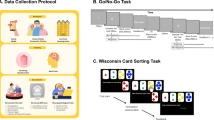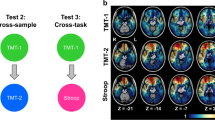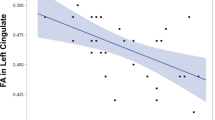Abstract
Poor task persistence is often observed among depressed individuals, and may be associated with some of the same frontal regions that are involved in depression. The current study explored the association between white-matter lesion volume in prefrontal cortex and noncompletion rates on a complex neurocognitive task among older adults in a treatment study for depression. Older adults in treatment for depression (n=83) and nondepressed (n=47) elders were administered the Stockings of Cambridge subtest (SoC) of the Cambridge Automated Neuropsychological Testing Battery (CANTAB) and completed a brain magnetic resonance imaging scan as part of an ongoing research study. Noncompletion of the SoC occurred in approximately 19% of depressed participants (16/83) and only 2% of nondepressed participants (1/47), which was statistically significant. In multivariate models, failure to complete the SoC was consistently and significantly associated with greater volume of white matter lesions in the anterior-most region of prefrontal cortex, particularly in the left hemisphere, and with greater age. Although SoC completion was not significantly associated with depression severity, noncompletion rates were significantly higher among unremitted individuals and those with comorbid anxiety at study entry. The inability to initiate behavior sufficient to sustain a complex neurocognitive task is a characteristic of geriatric depression which may be associated with integrity of left-prefrontal regions. Future research should investigate whether task impersistence is a construct that generalizes to other neurocognitive tasks, and if it is associated with other adverse outcomes in geriatric depression related to cerebrovascular pathology, such as poor treatment response.
Similar content being viewed by others
Log in or create a free account to read this content
Gain free access to this article, as well as selected content from this journal and more on nature.com
or
References
Alexopoulos GS, Kiosses DN, Choi SJ, Murphy CF, Lim KO (2002a). Frontal white matter microstructure and treatment response of late-life depression: a preliminary study. Am J Psychiatry 159: 1929–1932.
Alexopoulos GS, Kiosses DN, Klimstra S, Kalayam B, Bruce ML (2002b). Clinical presentation of the ‘depression-executive dysfunction syndrome’ of late life. Am J Geriatr Psychiatry 10: 98–106.
Alexopoulos GS, Meyers BS, Young RC, Kalayam B, Kakuma T, Gabrielle M et al (2000). Executive dysfunction and long-term outcomes of geriatric depression. Arch Gen Psychiatry 57: 285–290.
Baker SC, Rogers RD, Owen AM, Frith CD, Dolan RJ, Frackowiak RS et al (1997). Neural systems engaged by planning: a pet study of the Tower of London task. Neuropsychologia 34: 515–526.
Barrash J, Tranel D, Anderson SW (2000). Acquired personality disturbances associated with bilateral damage to the ventromedial prefrontal region. Dev Neuropsychol 26: 125–140.
Beats BC, Sahakian BJ, Levy R (1996). Cognitive performance in tests sensitive to frontal lobe dysfunction in the elderly depressed. Psychol Med 26: 591–603.
Cambridge Cognition Limited (2004). CANTABeclipse Test Administration Guide. Cambridge Cognition Limited: Cambridge, UK.
Cazalis F, Valabregue R, Pelegrini-Issac M, Asloun S, Robbins TW, Granon S (2003). Individual differences in prefrontal cortical activation on the Tower of London planning task: Implication for effortful processing. Eur J Neurosci 17: 2219–2225.
Chen PS, McQuoid DR, Payne ME, Steffens DC (2006). White matter and subcortical gray matter lesion volume changes and late-life depression outcome: a 4-year magnetic resonance imaging study. Int Psychogeriatr 18: 445–456.
Elliott R, Baker SC, Rogers RD, O'Leary DA, Paykel ES, Frith CD et al (1997). Prefrontal dysfunction in depressed patients performing a complex planning task: a study using positron emission tomography. Psychol Med 27: 931–942.
Elliott R, Sahakian BJ, Herrod JJ, Robbins TW, Paykel ES (2005). Abnormal response to negative feedback in unipolar depression: Evidence for a diagnosis specific impairment. J Neurol Neurosurg Psychiatry 63: 74–82.
Folstein M, Folstein S, Fanjiang G (2001). Mini-Mental State Examination: Clinical Guide and User's Guide. Psychological Assessment Resources: Lutz, FL.
Goethals I, Audenaert K, Jacobs F, Van de Wiele C, Ham H, Pyck H et al (2005). Blunted prefrontal perfusion in depressed patients performing the Tower of London task. Psychiatry Res 139: 31–40.
Gusnard DA, Ollinger JM, Shulman GL, Cloninger CR, Price JL, Van Essen DC et al (2003). Persistence and brain circuitry. Proc Natl Acad Sci USA 100: 3479–3484.
Kalayam B, Alexopoulos GS (1999). Prefrontal dysfunction and treatment response in geriatric depression. Arch Gen Psychiatry 56: 713–718.
Kiosses DN, Klimstra S, Murphy C, Alexopoulos GS (2001). Executive dysfunction and disability in elderly patients with major depression. Am J Geriatr Psychiatr 9: 369–374.
Kramer-Ginsberg E, Greenwald BS, Krishnan KRR, Christiansen B, Hu J, Ashtari M et al (1999). Neuropsychological functioning and MRI signal hyperintensities in geriatric depression. Am J Psychiatry 156: 438–444.
Krishnan KR, Taylor WD, McQuoid DR, MacFall JR, Payne ME, Provenzale JM et al (2004). Clinical characteristics of magnetic resonance imaging-defined subcortical ischemic depression. Biol Psychiatry 55: 390–397.
Lenze E, Cross D, McKeel D, Neuman RJ, Sheline YI (1999). White matter hyperintensities and gray matter lesions in physically healthy depressed subjects. Am J Psychiatry 156: 1602–1607.
Lockwood KA, Alexopoulos GS, van Gorp WG (2002). Executive dysfunction in geriatric depression. Am J Psychiatry 159: 1119–1126.
Montgomery SA, Asberg M (1979). A new depression scale designed to be sensitive to change. Br J Psychiatry 134: 382–389.
Muller MJ, Szegedi A, Wetzel H, Benkert O (2000). Moderate and severe depression. Gradations for the Montgomery-Asberg Depression Rating Scale. J Affect Disord 60: 137–140.
Naranjo CA, Tremblay LK, Busto UE (2001). The role of the brain reward system in depression. Prog Neuropsychopharmacol Biol Psychiatry 25: 781–823.
Newman SD, Carpenter PA, Varma S, Just MA (2003). Frontal and parietal participation in problem solving in the Tower of London: fMRI and computational modeling of planning and high-level perception. Neuropsychologia 41: 1668–1682.
Ozonoff S, Cook I, Coon H, Dawson G, Joseph RM, Klin A et al (2004). Performance on Cambridge neuropsychological test automated battery subtests sensitive to frontal lobe function in people with autistic disorder: evidence from the collaborative programs of excellence in autism network. J Autism Dev Disord 34: 139–150.
Payne ME, Fetzer DL, MacFall JR, Provenzale JM, Byrum CE, Krishnan KR (2002). Development of a semi-automated method for quantification of MRI gray and white matter lesions in geriatric subjects. Psychiatry Res 115: 63–77.
Pittenger DJ (2002). The two paradigms of persistence. Genet Soc Gen Psychol Monogr 128: 237–268.
Pizzagalli DA, Jahn AL, O'Shea JP (2005). Toward an objective characterization of an anhedonic phenotype: A signal-detection approach. Biol Psychiatry 57: 319–327.
Purcell R, Maruff P, Kyrios M, Pantelis C (1997). Neuropsychological function in young patients with unipolar major depression. Psychol Med 27: 1277–1785.
Reischies FM (1999). Pattern of disturbance of different ventral frontal functions in organic depression. Ann NY Acad Sci 877: 775–780.
Robbins TW, James M, Owen AM, Sahakian BJ, Lawrence AD, McInnes L et al (1998). A study of performance on tests from the CANTAB battery sensitive to frontal lobe dysfunction in a large sample of normal volunteers: Implications for theories of executive functioning and cognitive aging. J Int Neuropsychol Soc 4: 474–490.
Rogers MA, Bradshaw JL, Pantelis C, Philips JG (1998). Frontostriatal deficits in unipolar major depression. Brain Res Bull 47: 297–310.
Rolls ET (2000). The orbitofrontal cortex and reward. Cereb Cortex 10: 284–294.
Shallice T (1982). Specific impairments of planning. Philos Trans R Soc Lond B Biol Sci 25: 199–209.
Smeding HM, de Koning I (2000). Frontotemporal dementia and neuropsychology: the value of missing values. J Neurol Neurosurg Psychiatry 68: 726–730.
Steffens DC, Bosworth HB, Provenzale JM, MacFall JR (2002a). Subcortical white matter lesions and functional impairment in geriatric depression. Depress Anxiety 15: 23–28.
Steffens DC, McQuoid DR, Krishnan KRR (2002b). The Duke somatic treatment algorithm for geriatric depression (STAGED) approach. Psychopharmacol Bull 36: 58–68.
Steffens DC, Welsh-Bohmer KA, Burke JR, Plassman BL, Beyer JL, Gersing KR et al (2004). Methodology and preliminary results from the neurocognitive outcomes of depression in the elderly study. J Geriatr Psychiatry Neurol 17: 202–211.
Taylor WD, MacFall JR, Payne ME, McQuoid DR, Steffens DC, Provenzale JM et al (2005). Greater MRI lesion volumes in elderly depressed subjects than in control subjects. Psychiatry Res 139: 1–7.
Taylor WD, Steffens DC, MacFall JR, McQuoid DR, Payne ME, Provenzale JM et al (2003). White matter hyperintensity progression and late-life depression outcomes. Arch Gen Psychiatry 60: 1090–1096.
Tyson PJ, Laws KR, Roberts KH, Mortimer AM (2004). Stability of set-shifting and planning abilities in patients with schizophrenia. Psychiatry Res 129: 593–611.
van den Heuvel OA, Groenewegen HJ, Barkhof F, Lazeron RH, van Dyck R, Veltman DJ (2003). Frontostriatal system in planning complexity: a parametric functional magnetic resonance version of Tower of London task. Neuroimage 18: 367–374.
Acknowledgements
This study was supported in part by the Conte Center for the Study of Depression in Late-Life, including NIMH grants P50 (MH60451) and R01 (MH54846). Authors ADB and BJS were funded by the Wellcome Trust and worked within an MRC Center for Behavioral and Clinical Neuroscience when the manuscript was originally submitted. BJS is a consultant for Cambridge Cognition, and ADB assumed the position of Scientific Director for Cambridge Cognition during the revision of this manuscript.
Author information
Authors and Affiliations
Corresponding author
Rights and permissions
About this article
Cite this article
Potter, G., Blackwell, A., McQuoid, D. et al. Prefrontal White Matter Lesions and Prefrontal Task Impersistence in Depressed and Nondepressed Elders. Neuropsychopharmacol 32, 2135–2142 (2007). https://doi.org/10.1038/sj.npp.1301339
Received:
Revised:
Accepted:
Published:
Issue date:
DOI: https://doi.org/10.1038/sj.npp.1301339
Keywords
This article is cited by
-
Chronic Fluoxetine Induces Activity Changes in Recovery From Poststroke Anxiety, Depression, and Cognitive Impairment
Neurotherapeutics (2018)
-
Degree of contribution (DoC) feature selection algorithm for structural brain MRI volumetric features in depression detection
International Journal of Computer Assisted Radiology and Surgery (2015)
-
A “virtually minimal” visuo-haptic training of attention in severe traumatic brain injury
Journal of NeuroEngineering and Rehabilitation (2013)
-
Towards automated detection of depression from brain structural magnetic resonance images
Neuroradiology (2013)



